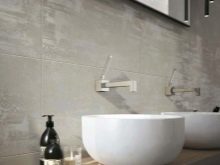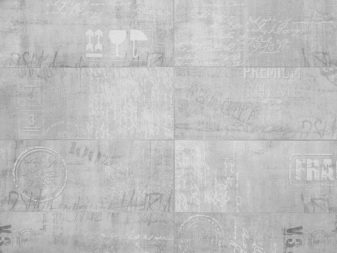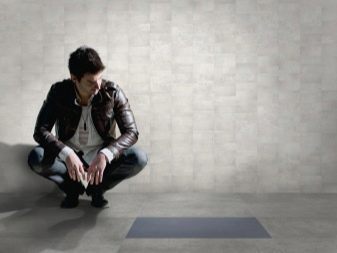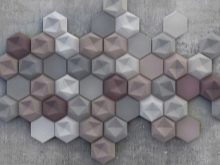Tile "under the concrete": the pros and cons

The modern range of tiles in building stores is quite wide, so during the renovation of the premises it is often very difficult to find the best option. This is not surprising, because good coverage should combine quality, safety, attractive appearance and affordable price.
Wall tiles made under concrete - this is quite a popular solution for interior decoration.because she has all the essential qualities needed. This coating will help create a modern atmosphere of simplicity and comfort in the room.
Special features
This type of tile is an imitation of building concrete, but there are many shades and textures of the material,thanks to which you can find a suitable option for a variety of interior styles. The most popular starting material for the manufacture of such tiles is granite.
The cost of an unusual coating will be much higher than the price of a standard ceramic tile, but as a result you can get a stylish and dynamic design that will please the eye for many years.
The average service life of products, depending on operating conditions and proper installation, can vary within 20-30 years, and sometimes it exceeds even half a century.
The advantages of concrete tiles
Concrete in itself is a rather unattractive material, so many do not believe that its use in the interior of a room can add to the atmosphere of beauty and comfort. However, the tile, decorated under concrete, only vaguely resembles the given building material, since it looks very neat and restrained.
Such coverage can be taken as a basis for the decor, with the help of it emphasizing other, brighter details. You can dwell on such a tile as the main element of the interior, creating a very simple, relaxed and minimalistic design of the room.
Highlight the main positive qualities of "concrete" finish:
- Versatility. Tile, made under concrete, is quite unusual, but at the same time very versatile coating. It fits perfectly into many styles of the interior, creating an unobtrusive basis for highlighting bright details or becoming the main focus of housing decoration. This type of coating can be combined with many other popular materials, for example, wooden or metal elements, glass inserts and furniture.
- Easy care. The tile of such a plan does not require special expensive care products and does not take much time to clean. The surface is quite non-marking, so it will not quickly become dirty and will keep a neat vernal appearance. In addition, due to the reduced number of joints between the plates will not accumulate dirt. In order to remove stains and scuffs from a tile, it is enough to periodically wipe it with a rag or foam sponge.
- Durability. Considering that the main material for the manufacture of tiles for concrete is granite, we can say that such a coating will be very durable and will last for many years.With proper installation of such a tile will not cleave or move away from the surface, it will not be covered with cracks. The material is also quite resistant to physical effects, therefore, it will not be overwritten and lose its visual appeal for a long time. Having made repairs once, it will be possible to forget for a long time about the additional expenses for updating the coverage, and to save a lot of money and time.
- The possibility of changing the design. Since the tile, made under the concrete, is the base material, it can be used in the interior not only in its pure form. Such a coating will allow you to show your imagination and decorate the walls depending on your personal taste preferences - paint it, apply any patterns, create an odd shape of plates or lay out an interesting pattern.
The disadvantages of this material include the following points:
- Laying such a coating is a more laborious process than installing ordinary ceramic tiles. This is due to the shape of the plates, which are usually made in the form of an elongated rectangle.
- For the installation requires a special adhesive solution, because the material is water-repellent.Glue should not be made on the basis of cement.
- The cost of such a coating will be higher than the laying of conventional ceramic tiles, since the material for its manufacture cannot be classified as the cheapest.
The disadvantages of this material are insignificant, since investing large amounts of tile in itself, selecting the right adhesive and costly installation time can result in a reliable, functional and durable coating that will create a unique style in any room.
Material selection
Porcelain tile is a building material with a rather large weight, so most often it is used for decorative flooring. However, tiles decorated with concrete are also made for flooring and wall cladding. As for the ceiling coating, this material is not very popular in this direction, but sometimes there are options for interesting rooms with a ceiling covered with such tiles.
In order not to be mistaken when buying a finishing material, you should first pay attention to the thickness of the plates. Tiles designed for laying on the floor will be much greater than the thickness of the material for the walls, since it accounts for the greatest load.Porcelain tiles for walls and ceilings will be much thinner, so that the material does not begin to depart from the surface under its own weight.
Glue mix is selected in accordance with the purpose of the tile. When installing the coating on the walls, the main requirement for glue is good adhesion to the surface and high elastic properties. Without these characteristics, the tile will simply not stick to the wall, falling off from the surface along with the glue, or the glue will crack, which will also lead to the deformation of the coating.
When covering the floor tiles it is recommended to use the adhesive composition, which is indicated in the instructions for building materials. Usually this is a type of standard adhesive mixture for flooring.
Mixtures based on cement should not be used for these purposes due to their poor adhesion with the material itself. In addition, porcelain - moisture-resistant coating, which means that the cement mixture under it simply does not dry out.
A good mix option is ready-made polymer glue. It does not require additional time for the manufacture of the solution, as it is already sold for use. To secure the plates does not require a thick layer of the mixture, it dries well and has high adhesion to the surface.The disadvantage of this adhesive composition is its price, much higher than the cost of cement mixtures.
It is necessary to pay attention to the operating conditions of the adhesive, which are usually indicated on its packaging. The main qualities that such a composition should possess are resistance to low temperatures and elasticity. In addition, if in the room where the repairs are carried out, there are certain adverse conditions, it is necessary to find such glue that is designed for use in these conditions.
For information on how to use tiles for concrete and cement in the interior, see the following video.

















































